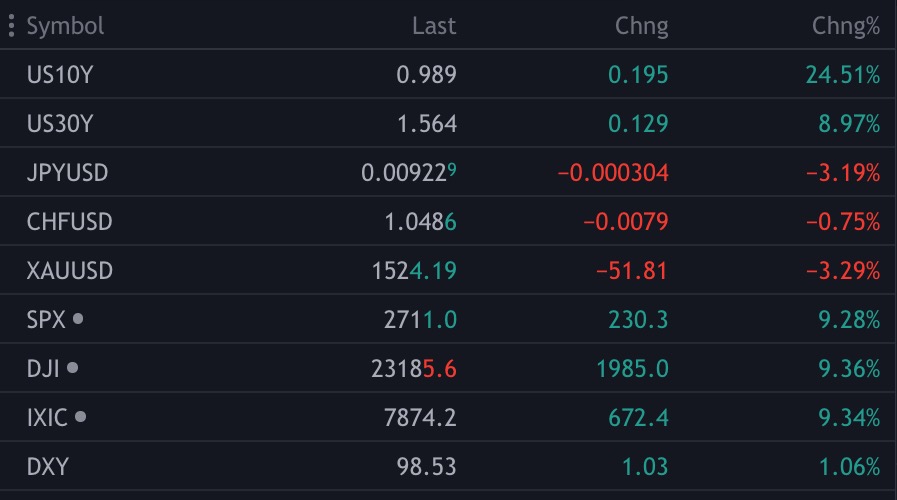BY
In a volatile trading session, Wall Street staged a heated rally just before closing bell Friday after President Donald Trump declared a national emergency, bringing to bear an arsenal of measures to counter the economic impacts of the coronavirus outbreak.
“To unleash the full power of the federal government in this effort today, I am officially declaring a national emergency. Two very big words. The action I am taking will open up access to up to $50 billion—a very important and a large amount for states and territories or localities in our shared fight against this disease,” Trump said at a press conference at the White House Rose Garden on Friday.
Trump warned that the outbreak could get worse before it gets better, adding, “The next eight weeks will be critical.”
All three major stock indexes—the Dow Jones (DJI), the Nasdaq (IXIC), and the S&P 500 (SPX)—gapped up by over 5 percent on open after Thursday’s thrashing that saw both the blue-chip Dow and the benchmark S&P 500 notching their worst single-day drops since the Black Monday crash of 1987.
The rally then faded to just over 1 percent up around midday, before sprinting in the waning moments of the session to close over 9 percent up after Trump delivered his remarks.
“President Trump’s national emergency declaration was a turnaround performance relative to his travel ban announcement,” said Allen Sukholitsky, chief macro strategist at Xallarap Advisory. “The equity market took note, turning a positive day into an even more positive one. It remains unclear, however, how the market will react to an inevitable spike in infected cases after the implementation of broader testing procedures,” he told The Epoch Times in an emailed statement.
As stocks surged, safe-havens like bonds, gold, and the Japanese yen gave ground.
According to Refinitiv Eikon data, the DJI rose 1,985 points, or 9.36 percent, to 23,185.62 points; the SPX gained 230.38 points, or 9.29 percent, to 2,711.02 points; and the IXIC added 673.07 points, or 9.35 percent, to 7,874.88 points.
According to TradingView figures, the benchmark 10-year U.S. Treasury note yield lifted by 24.51 percent to 0.989 percent, while the gold spot price fell by 3.29 percent to $1,524.19 per ounce, signaling investor disinclination for safe-haven plays.

Table showing the US 10-year and 30-year Treasurys, the Japanese yen / US dollar and Swiss franc / US dollar currency pairs, the gold spot price, the S&P 500, Dow Jones, Nasdaq, and the DXY dollar index. (TradingView)
“Today’s Trump press conference was just what the doctor (that is, the market) ordered,” said Robert Johnson, Professor of Finance at Heider College of Business, Creighton University. “In contrast to Wednesday’s speech, the focus of today’s remarks was on the public health crisis and the need for widespread testing,” Johnson told The Epoch Times in an emailed statement.
“The coronavirus crisis is at its core not an economic one, but is a public health crisis and the stock market responded to that focus today,” he added.
“Well, a relief rally. And also I think the concerns we all had yesterday, the fear and the anxiety and the worry that we wouldn’t see another up day, but then here we get this today is just proof that this market is resilient. We will get past this. There will be more up days ahead,” said Julia Carlson, Founder of Financial Freedom Wealth Management, in remarks to Reuters.
Still, the indexes closed about 20 percent below record highs hit in mid-February, and each saw declines of at least 8 percent for the week.
Markets have been rocked by wild swings since hitting the highs, with the implied volatility index (VIX), sometimes referred to as the Wall Street fear gauge, closing at 57.83 on Friday, well above its informal red-line of 31, above which outsized levels of fear, uncertainty, and doubt prevail.
The spectacular return of volatility to equities markets is also fueling expectations that the central bank’s rate-setting body, the Federal Open Market Committee (FOMC), will slash interest rates to zero when it meets next Wednesday to determine its target Federal funds rate.
“In light of the continued growth in coronavirus cases in the U.S. and globally, the sharp further tightening in financial conditions, and rising risks to the economic outlook, we now expect the FOMC to cut the funds rate 100 basis points on March 18,” Goldman Sachs Group Inc. chief economist Jan Hatzius and his colleagues wrote in a note Thursday, as cited by Bloomberg.
Markets have priced in as much as a 95 percent probability that the FOMC will slash rates by 100 basis points to a target range between 0 percent and 0.25 percent, according to the CME FedWatch Tool.
A 100-point cut would be the Fed’s biggest since December 2008 when it brought rates to zero, warning in a statement that “labor market conditions have deteriorated, and the available data indicate that consumer spending, business investment, and industrial production have declined.”
The FOMC’s next meeting is scheduled for March 17-18 in Washington.
Reuters contributed to this report.
Republished with Permission The Epoch Times SUBSCRIBE
Get Citizensjournal.us Headlines free SUBSCRIPTION. Keep us publishing – DONATE




